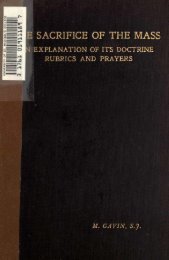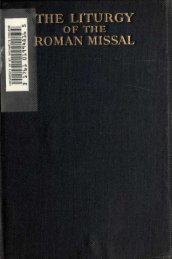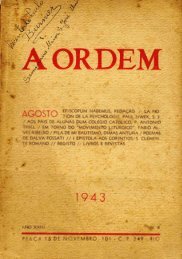E SACRIFICE OF THE MASS
E SACRIFICE OF THE MASS
E SACRIFICE OF THE MASS
You also want an ePaper? Increase the reach of your titles
YUMPU automatically turns print PDFs into web optimized ePapers that Google loves.
<strong>THE</strong> CEREMONIES <strong>OF</strong> HIGH <strong>MASS</strong>. 159<br />
to Bishops, and as early as the fourth century to<br />
deacons. From the year 800 onwards ecclesiastical<br />
writers speak of the dalmatic as one of the episcopal<br />
and the chief of the deacon s vestments. (Cath. Diet.<br />
Sixth Edition, p. 268.)<br />
High Mass differs from Low (so called by way of<br />
contrast to the High, the Great, the Solemn Mass)<br />
merely in the way of addition. It is substantially the<br />
same rite. But such is the dignity of this great Sacrifice,<br />
that the Church prefers its being solemnized with all<br />
outward sign of grandeur and beauty. It is certain that<br />
Masses are much more frequent in later than in earlier<br />
ages. Thus St. Augustine, speaking of his day, informs<br />
us that in some places there was Mass daily, in others<br />
only on Sundays, in others on Saturdays and Sundays.<br />
The multiplication of Masses has necessarily tended to<br />
divest them of all ceremonial except what is necessary<br />
to their essence. But High Mass is more in accordance<br />
with the mind of the Church than Low. And she has it<br />
on every great feast.<br />
The first ceremony after the priest reaches the altar<br />
is the incensing.<br />
Incensing is very<br />
ancient in the Church and was<br />
prescribed by God Himself in Exodus xxx. 7 :<br />
" And<br />
Aaron shall burn sweet-smelling incense upon it in the<br />
morning." The Council of Trent mentions incense<br />
(Thymiama) amongst those visible signs which lift the<br />
mind to heavenly things. (Sess.<br />
xxii. ch.<br />
5.) The burning<br />
away of the incense, in other words its destruction, is<br />
suitable to the idea of Sacrifice where the Victim is<br />
destroyed, and the perfume, which is of strict obligation,<br />
is emblematic of the good odour of Christ of which the<br />
Sacrifice speaks.<br />
The first incensing of the altar by the priest may be






